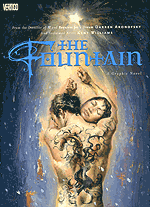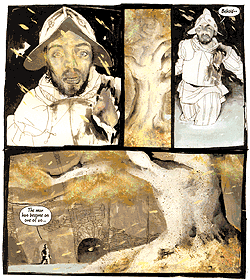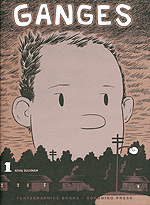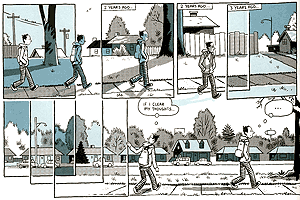
|
Following a strange path, The Fountain began as an epic Brad Pitt vehicle written and directed by Aronofsky, whose indie movie ? combined sci-fi, mysticism and math to much critical acclaim. Reportedly budgeted at $75 million in 2002, The Fountain was well into pre-production when Pitt dropped out, closing the project. Continuing an emerging trend of turning failed film projects into comix (see Birth of a Nation), The Fountain represents a visualization of that lost picture. However, simultaneously with working on the book, Aronofsky developed a scaled-down movie version, starring Hugh Jackman, which is now in post-production and is due for release this year. From the look of the the trailer, the story remains the same, though the director has said there are differences between the book and the film.
Whatever the case, The Fountain graphic novel certainly reflects its ambitious origins. It spans 1,000 years, from the Spanish conquests of the New World in the 1500s, through today, and up until 2500 when we are imagined to be flying through the cosmos in very large, clear bubbles. Through the past, present and future appear the same two lovers, Thomas and Isabel, though in different guises and circumstances. The sequences weave in an out of each other like a dream as in each one Thomas searches desperately for a panacea that will save his endangered beloved and allow them to be together forever. The central symbol of the book, and the object of Thomas' quests, is a magical Tree of Life. (The title's erroneous reference to the Fountain of Youth, which does not appear in the book, remains unexplained.)
 Thomas meets the Tree of Life in Aronofsky & Williams' "The Fountain"
Thomas meets the Tree of Life in Aronofsky & Williams' "The Fountain" |
The earliest tale has Thomas the Conquistador seeking the tree for his lover Isabel, the Queen of Spain, who is under threat by conspiring forces of the Holy See. The book opens with a Hollywood style set piece as Thomas leads a band of soldiers in an assault on a huge Mayan temple thought to contain the Tree. As hundreds clash on the temple steps a stony-eyed Mayan priest tears the still-beating heart out of a Franciscan friar. It's an exciting sequence that takes best advantage of artist Kent Williams' ability to combine expressive, natural characterization with fantastically interpretive imagery. In a class with the mixed-media work of Bill Sienkiewicz (Electra: Assassin) and Dave McKean (Cages), Williams combines pen and ink with bursts of rich, painterly color. It's a style that best serves the most outrageous sequences, like the future third of the book, depicting Thomas as a lonely, nude space traveler. Haunted by the ghost of Isabel, he searches for a dying star that he hopes will re-invigorate the Tree of Life that he carries on his soap-bubble ship.
But when Aronofsky and Williams tone it down for the modest middle sequence, where modern-day researcher Thomas hunts for a cancer cure that will save his wife, the book becomes an unconvincing melodrama with two stock archetypes: the driven scientific male who struggles to defeat death and the beatific, artistic female who courageously accepts it. Without the star wattage of real people to put over the chemistry of the characters, the authors never build up a convincing case for the timelessness of this relationship. They need to stretch out the quiet bits, but, even at over 160 pages, the pace has the accelerated feel of compressed film script.
This compression muddles the meaning of the story. It appears to be a large-scale fable about the fallacy of seeking eternal life. But much of its philosophy and even its narrative remains an enigma, either by design or oversight. For example, Aronofsky blurs the relationship between the different Thomases so you don't know if they are all the same man or reincarnations of the same spirit or if one is a fiction in another's world. Perhaps we aren't supposed to know, which is fine, but it's not a particularly interesting mystery. The book reads like a static version of an over-worked Hollywood movie — full of arresting special effects but no believable characters or particular meaning.

|
The content and form of Kevin Huizenga's Ganges couldn't be further from The Fountain, though they share many of the same themes. Fifth in a line of upscale comic books that the co-publishers hope will fill the gap between more cheaply produced pamphlets and pricey full-length books, the other authors in this "Ignatz" series have all been Europeans until now. Huizenga hails from Illinois and creates the most suburban comix to be found in the alternative market. His regular series Or Else has been reviewed by TIME.comix, and he specializes in small-scale narratives of riding bikes or bringing home the groceries that end up becoming part of larger cosmological considerations. His principal character, a bland looking guy in his late twenties(?) named Glenn Ganges, sports softball T-shirts, drives a compact car and spends his leisure time at home with his wife Wendy, reading books.
Huizenga's world of suburban sprawl may therefore seem a bit more familiar to you than that of The Fountain unless you are a conquistador, research scientist or space traveler. At first lulling you with ordinariness, Huizenga then brilliantly brings the fantastic to the mundane, as in Ganges's opening tale, "Time Traveling." It starts with Ganges taking a walk to the library on an early spring day. As he strolls, he reminisces about doing the same thing at the same time the previous year. The following panel, with a note in the corner saying "Last spring," exactly mimics the panel preceding. Was it a flash back or did Glenn actually appear in the past for a moment? Does the memory of a thing constitute a kind of reality so that we can be said to be "time traveling" when we think of the past? Huizenga plays with such considerations using the unique language of comix. The panels, which essentially frame a finite period of time, begin to overlap. Glenn steps out of the panel border and walks around to another panel. Soon Glenn has come up with a fairly reasonable argument for how time is illusory. Huizenga takes the quasi-profound day-dreamy musings of an average guy's walk down the street and puts them into art.
 Glenn Ganges travels through time on his way the library in Kevin Huizenga's "Ganges" #1
Glenn Ganges travels through time on his way the library in Kevin Huizenga's "Ganges" #1 |
Like Aronofsky, Huizenga also deals with love, and the desire to make it last in the face of inevitable decay and death. In a pair of related stories Ganges sits at home with his wife. In the first, they get into a discussion of the Beatle's song "She's Leaving Home," which Wendy feels is "lame," but Glenn defends as touching. Though the debate centers on a song about a child leaving her parents, the idea of being elderly and alone suddenly causes Wendy to burst into tears. Later, in the second vignette, Glenn lies next to his sleeping wife and thinks about how much she means to him. In a stunning sequence of pages that combine dark-hued tableaus of a quiet bedroom at night with an imagined universe of sleeping couples past and present, Glenn's over-caffeinated brain considers the beauty of love and the sadness of parting. Even those unlucky enough to have never felt a powerful need to be with another person will be touched by Huizenga's ability to get at the heart of our most tender and quietest of domestic moments.
While Ganges and The Fountain may share similar themes, they do not share a similar look. Huizenga's drawing style doesn't remotely echo that of Kent Williams. Huizenga takes his cues from the likes of Harold Gray's "Little Orphan Annie," where simplified characters with dots for eyes live in pared-down environments. Touching on the Sunday comics as it does, Huizenga's artwork carries with it a sense of whimsy, while the single blue tone brings depth to the frames and gives them a cool atmosphere. The only point of comparison between the artists' styles is their use of layout. Both put readability as a priority, keeping the panel arrangements varied but never confusing, occasionally breaking out of the usual arrangements for heightened effects. But where Williams puts the layout at the service of visual excitement, as in his full-page "splash" of the Tree floating in a bubble in outer space, Huizenga's pop-out moments, like a full page "splash" of Glenn and his wife laying quietly in bed, evoke a greater meaning.
For those with an interest in strong artwork, lots of action and a simulacrum of deep thought, Aronofsky and Williams' The Fountain would be the better choice. Others who want to experience their own world as something powerful and deep, and find entertainment in ideas rather than images, shouldn't miss Kevin Huizenga's Ganges #1.
